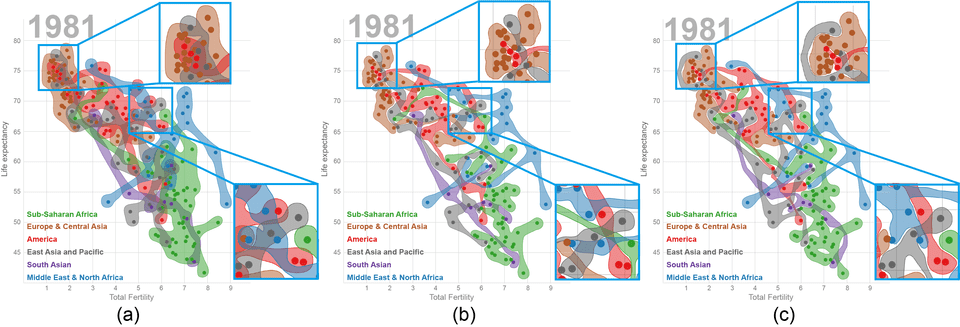F2-Bubbles: Faithful Bubble Set Construction and Flexible Editing
Yunhai Wang, Da Cheng, Zhirui Wang, Jian Zhang, Liang Zhou, Gaoqi He, Oliver DeussenAbstract
In this paper, we propose F2-Bubbles, a set overlay visualization technique that addresses overlapping artifacts and supports interactive editing with intelligent suggestions. The core of our method is a new, efficient set overlay construction algorithm that approximates the optimal set overlay by considering set elements and their non-set neighbors. Thanks to the efficiency of the algorithm, interactive editing is achieved, and with intelligent suggestions, users can easily and flexibly edit visualizations through direct manipulations with local adaptations. A quantitative comparison with state-of-the-art set visualization techniques and case studies demonstrate the effectiveness of our method and suggests that F2-Bubbles is a helpful technique for set visualization.
Results
Figure 1: Set visualization of (a) F2-Bubbles right after adaptive construction, (b) after editing, (c) Bubble Sets, and (d) KelpFusion. All sets are visualized over the map of Manhattan (New York). Hotels, subway stations, and clinics are visualized as bubble sets in orange, brown, and purple.
Figure 2: Set visualization of (a) Bubble Sets, (b) F2-Bubbles, and (c) F2-Bubbles after editing 2D scatterplots of life expectancy versus total fertility of countries and regions of the year 1981. Sets are colored based on geographic regions of the world as shown in the legend.
Figure 3: Visualizations of NBA (National Basketball Association) season awards for the years 2010 to 2020 with (a) Bubble Sets, and (b) F2-Bubbles. The horizontal axis of the timeline shows the teams in which the awarded players served, while the vertical axis is the year of the season. Players are indicated by their photos, the winner teams are shown with winner cups. Sets are color-coded by the award type as shown in the legend.
Acknowledgements
This work is supported by the grants of the National Key Research & Development Plan of China (2019YFB1704201), NSFC (61772315, 61861136012), CAS grant (GJHZ1862), Beijing Advanced Discipline Construction Project (BMU2019GJJXK001), PKU-Baidu Fund (2019BD017), and Deutsche Forschungsgemeinschaft (DFG) Project DE 620/26-1.


